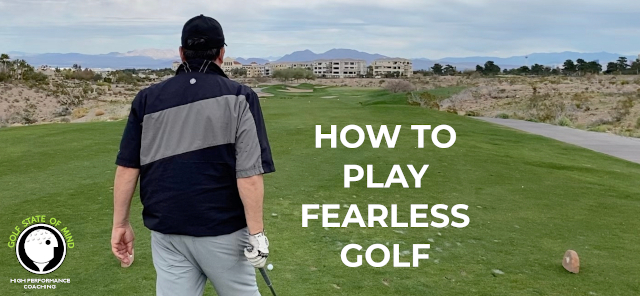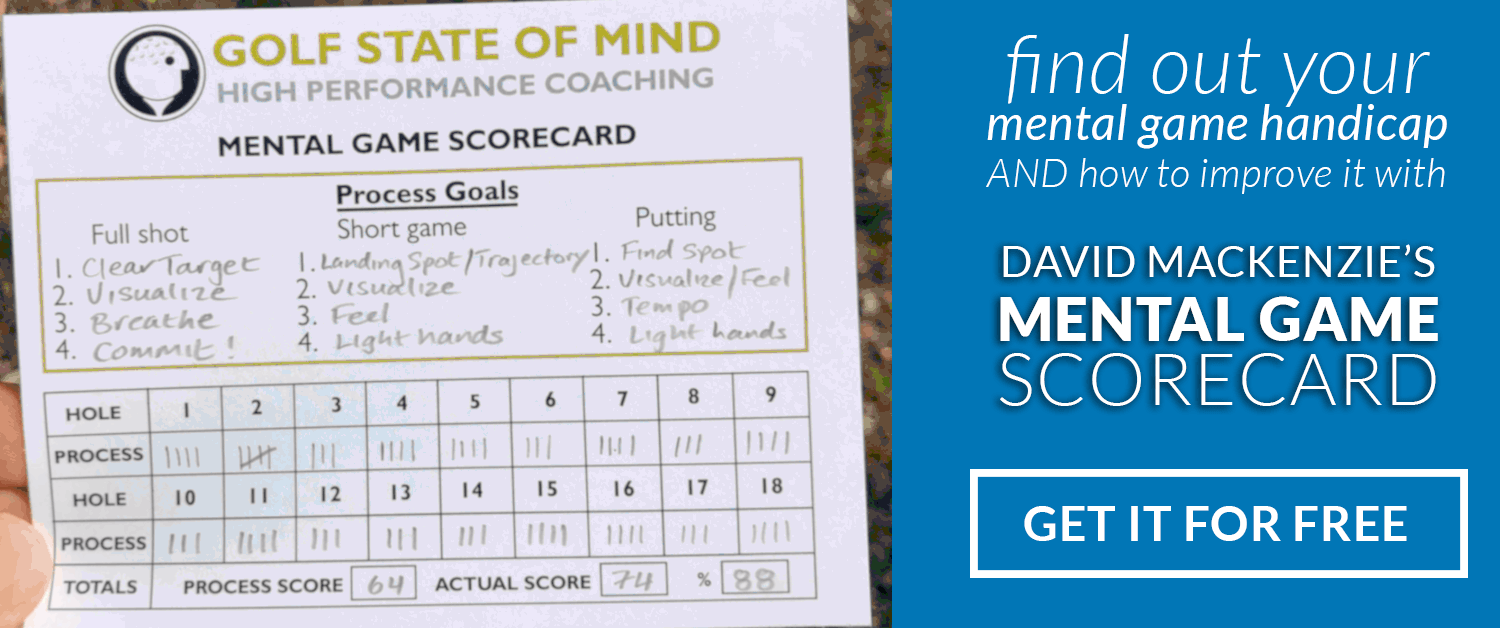
How To Play Fearless Golf
Do you put in the hours practicing and feel like your game is in good shape, only to feel anxious and under-perform in competitions? Do you know you have the skills to play at a higher level but there’s something deep down that pulls you back to your normal level of play? If so, I’ve got a solution for you to play more fearless golf.
Performance anxiety is a sign that your “autonomic” system is at work, doing its best to keep you in you away from potential threats – even if the only “danger” is nothing worse than shooting a high score.
When it senses that danger or uncertainty might lie ahead, the autonomic system starts those uncomfortable feelings and anxiety, in the hope that you submit to them and change direction. But, as you know, in order to succeed and play well, you will have to manage those feelings and performance anxiety, and push forward.
In addition to good relaxation techniques for golf, there is another way to allow you to play fearless golf when it counts.
This technique (which can be done at home) is used by many of the worlds most successful business leaders and athletes to overcome their fears, increase self-belief and their confidence in what is possible.
This technique can help you:
-
Develop positive habits – change the way you “automatically” behave
Reduce fear and increase confidence
Improve your swing – it’s been proven that the brain can learn physical skills in the absence of actual movement
Get your mind ready for action
Bring your goals closer towards you
What Is The Subconscious Mind?
Scientists tell us that only about 3% of our processing power is consciously controlled, the remaining 97% is subconscious or automatic. E.g. You don’t have to think about how to digest food, keep your heart pumping or breathe. The same goes for most of your habits, patterns of thinking and behaviors. They happen automatically or “subconsciously”. To use an analogy, you can think of your conscious mind, or “the thinking mind”, as the screen of your computer or device that you are looking at now, and the subconscious mind as the apps (your habits and behaviors) and all the information on web pages and files it has access to (your memories). The subconscious mind is thought to be a million times more powerful than the conscious mind, so if you can learn to tap into it and get it working for you, it can take you closer and closer to your dreams.
Your subconscious mind’s primary role is to keep you alive and safe. Not only does it control the majority of our bodily functions, it’s also responsible for keeping us away from potential threats, by making you tense and triggering anxiety (“the stress response”).
Unfortunately for us, it doesn’t have to be a threat of actual physical danger, but any situation that might make us feel uncomfortable. Whenever your subconscious mind senses that you are out of your “comfort zone”, it’s going to try to bring you back to it and keep you away from harm. It uses a combination of your past memories and associations of what you are experiencing in that moment, or with what you are consciously thinking about, to determine whether you are in a safe place or not.
For example, let’s say you can get anxious over short putts. This is probably because you have stored (subconscious) memories of the mental and emotional pain caused by missing short putts, and now (without consciously thinking about it), those same emotions are triggered along with tension, increased heart rate and lack of focus. You fear it happening again, which increases the chances of that repeating itself.
The good news, is that whatever it is that you fear, it’s possible to reduce it by using a technique called Mental Rehearsal.
Mental Rehearsal For Golf
Mental rehearsal works because your subconscious mind doesn’t know the difference between what’s real or imagined. Your memories are obviously real experiences, but you can create new associations or change existing ones by using the power of mental rehearsal and “reprogramming” your subconscious mind.
When you have a positive association or memory with a situation, your subconscious mind will give you a “green light” (by sensing no threat) to play fearless golf
If you can feed the subconscious mind the images of you excelling and/or overcoming fear, it can help you reduce fear and have more confidence, when you are in that situation for real. Using the computer analogy I referred to earlier, by using mental rehearsal we have ability to get into the apps and programs of the computer and have it operate more how we would like (and change our behaviors, habits and our patterns of thinking).
How To Practice Mental Rehearsal
To play more fearless golf, I recommend doing the following exercises daily for 20 minutes, either before sleep and/or after waking up. The more you do it, the more you strengthen the connections and change your behaviors and habits in reality.
1. Meditate or do relaxation exercises
By slowing down your brain waves (thinking less), you will have a better connection with your subconscious mind, because there is less noise and interference from your mental chatter.
2. Identify what behaviors you want to change
For example, this could be feeling more confident, instead of overly nervous on the first tee, being more confident over short putts, or closing out a win.
3. Visualize playing fearless golf
Make your visualization for golf as vivid as possible and see the course in detail. Try to engage the senses – feel the wind, smell the grass and hear the birds. Experiment with first and third person perspectives. Bring movement into it by actually going through your pre shot routine and making your swing. Feel your tension level, tempo and see the outcome you want as the ball travels to the target. Add as much detail as possible by acknowledging the comments of “great shot” by those watching. Imagine how relaxed and confident you will be during your shots and in between shots – your body language, demeanor and facial expressions.
4. Ingrain your new perspective using mantras
Find keywords which you can use to anchor to your new behaviors and include them in mantras which you can use before and during your rounds. Examples are:
“I am relentless and thrive during competition!”
“I stick to my process until the holes run out”.
“From start to finish, I stay emotionally balanced by using my breathing to keep myself serene, level headed and in the moment, no matter what adversities the game throws at me”.
Summary
Conscious determination and thousands of hours spent practicing is not enough to take you to your full potential. You might have the skills, but it’s your mind that’s ultimately going to get you across the line in achieving your goals. With a regular practice of mental rehearsal, as a compliment to your current game improvement regimen you can build the belief system and the automatic behaviors that will help you achieve it.



Younger players are more fearless than older players, wonder why. Mental rehearsal is an interesting concept that trains your mind along with training your skills.